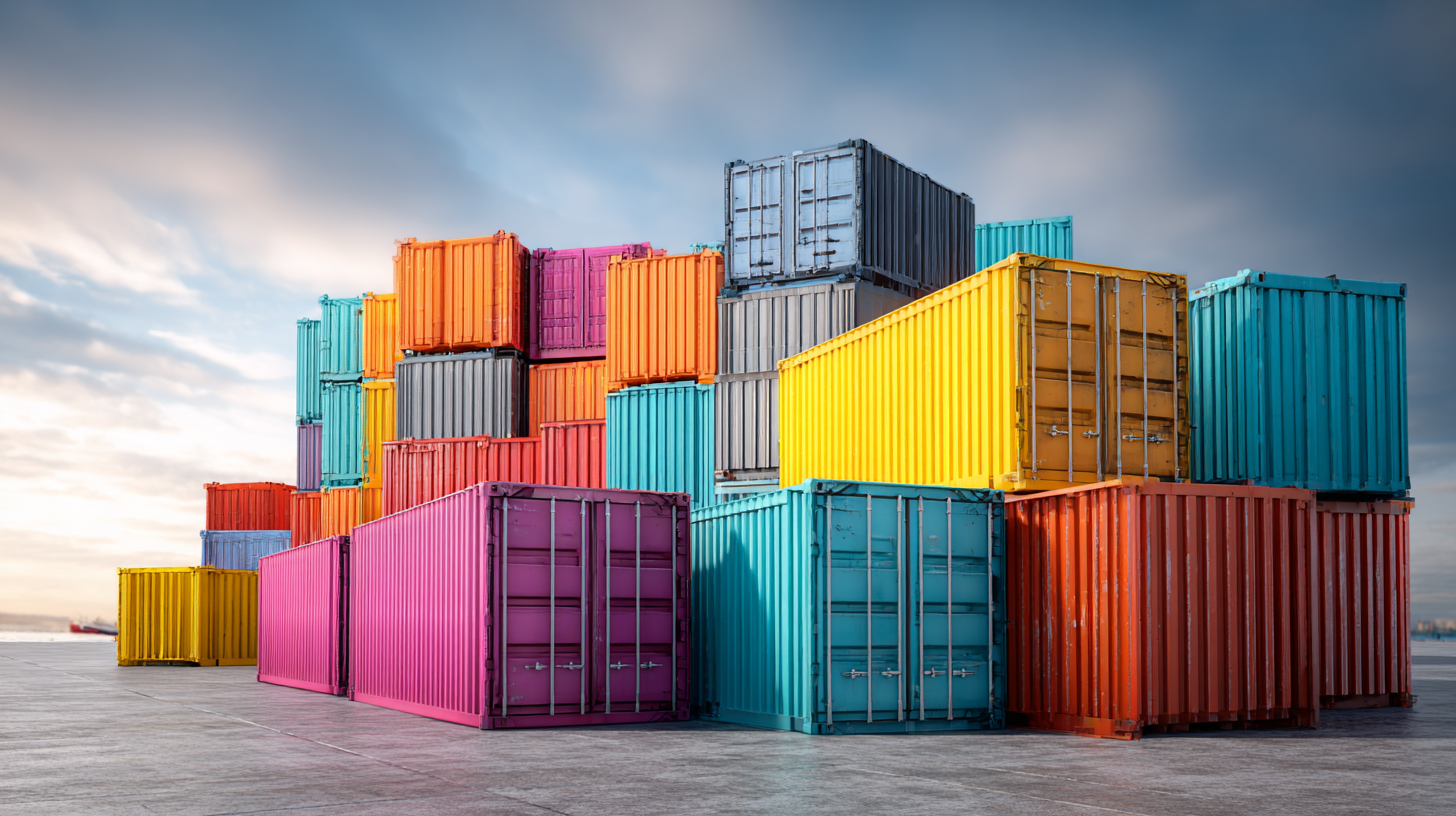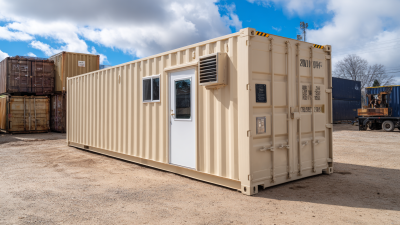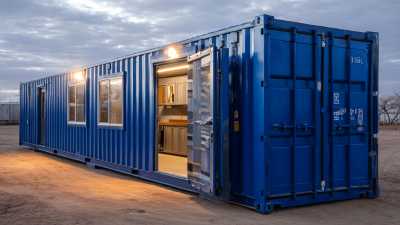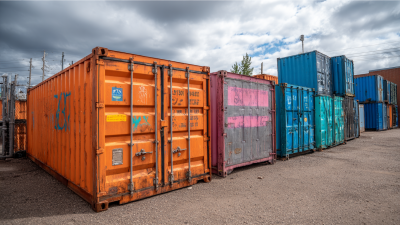In the ever-evolving landscape of global logistics, one way shipping containers have emerged as a cornerstone for enhancing supply chain efficiency and reducing operational costs. According to the latest report by the International Council of Containers, the use of one way shipping containers has increased by over 30% in the past five years, primarily due to their ability to streamline the logistics process and minimize the need for return shipping. Industry expert Dr. James Reynolds, a noted authority in container logistics, asserts, "One way shipping containers significantly optimize transport routes, leading to faster deliveries and reduced carbon footprints."

As businesses expand their operations across continents, the demand for innovative shipping solutions continues to grow. One way shipping containers provide flexibility and cost savings, allowing companies to ship goods without the burden of returning empty containers. Recent studies indicate that this approach can save up to 15% on shipping costs while also improving overall shipment turnaround. The transition towards adopting one way shipping containers not only caters to the economic needs of businesses but also aligns with global sustainability efforts aimed at reducing waste within the shipping industry.
By harnessing the advantages of one way shipping containers, stakeholders in the logistics sector can unlock a myriad of benefits that enhance efficiency, reduce costs, and contribute to more sustainable transport practices. As the industry moves forward, understanding these benefits will be crucial for companies looking to maintain a competitive edge in the global market.
The rise of one way shipping containers has significantly transformed global trade, offering an innovative solution to the logistics challenges faced by businesses today. Traditionally, shipping containers have been used in a return cycle, where they are sent back to their point of origin after delivery. However, one way shipping containers are designed for single-use journeys, allowing companies to optimize their shipping routes and reduce costs associated with returns. This shift not only enhances efficiency but also streamlines the supply chain, making it a popular choice for many exporters and importers.
Moreover, this model promotes sustainability by reducing the carbon footprint linked to transporting empty containers back to their origin. As global trade continues to expand, businesses are increasingly recognizing the advantages of utilizing one way shipping containers. They offer flexibility in logistics and can be tailored to meet the varying demands of different markets. The adoption of this shipping method signifies a response to both economic pressures and the need for more eco-friendly practices within the industry, further solidifying its importance in modern trade.
| Aspect | Description | Benefits | Cost Efficiency | User Adoption Rate |
|---|---|---|---|---|
| Flexibility | One way shipping containers are designed for single-use, reducing the need for return trips. | Enhanced logistical efficiency and less downtime. | Reduced transportation costs associated with return journeys. | Increasing trend, currently around 65% among exporters. |
| Sustainability | One way containers facilitate a more sustainable supply chain. | Lower carbon footprint by reducing empty container returns. | Overall decrease in fuel consumption. | Adopted by 75% of eco-conscious companies. |
| Speed | One way shipping reduces transit time since no return trip is required. | Faster delivery times improve service quality. | Minimized wait times lead to better inventory management. | Significantly growing among 70% of fast-paced industries. |
| Cost Predictability | Fixed costs with no returns or unexpected fees. | Clear budgeting for shipping expenses. | Increased financial control for businesses. | Used predominantly by 80% of logistics firms. |
One way shipping containers have emerged as a game changer for businesses looking to optimize their logistics and reduce expenses. Unlike traditional shipping practices that involve round trips for containers, one way containers are designed for a single journey, allowing companies to avoid the costs associated with returning empty containers. This method helps streamline operations and eliminates the hassle of managing container returns, ultimately leading to substantial savings.
From a financial perspective, the cost-effectiveness of one way containers is clear. Businesses can take advantage of lower shipping rates, as the demand for one way containers has grown due to their efficiency. Moreover, by eliminating the need for reverse logistics, companies can allocate their resources more strategically, focusing on core operations rather than container management. This shift not only enhances profitability but also allows for greater flexibility in international trade, making one way shipping containers an ideal choice for modern businesses aiming for greater efficiency in global transport.
One-way shipping containers offer significant environmental benefits, making them an attractive choice for global transport. By utilizing these containers, businesses can reduce their carbon footprint considerably. According to a report from the IMO, shipping is responsible for around 2.2% of global greenhouse gas emissions. However, the adoption of one-way shipping solutions can streamline logistics processes, thereby optimizing transport routes and minimizing empty trips—an essential factor in reducing emissions. A study from the Global Logistics Council indicated that companies implementing one-way shipping reduced emissions by up to 30%, underscoring the potential for significant environmental impact.
Tip: Evaluate your shipping routes and consider adopting a one-way shipping model to maximize efficiency and sustainability. By consolidating shipments and using containers specifically designed for one-way use, businesses can enhance their operational efficiency while contributing to environmental preservation.
Moreover, one-way shipping containers promote the principle of circular economy by encouraging the reuse and recycling of materials. According to the Ellen MacArthur Foundation, transitioning to a circular economy can save businesses in the logistics sector approximately $1 trillion by 2025. This model not only minimizes waste but also reduces the demand for new containers, ultimately leading to lesser resource consumption and landfill contributions.
Tip: Collaborate with partners who prioritize sustainability in their supply chain practices. By choosing operators that utilize one-way shipping solutions, businesses can strengthen their commitment to environmental responsibility while optimizing costs.
One way shipping containers are revolutionizing the logistics industry by streamlining global transport processes. With the increasing need for cost-effective and efficient shipping solutions, companies are turning to one way container shipping as an alternative to traditional methods. According to a report by the International Maritime Organization, utilizing one way containers can reduce transportation costs by up to 30%, making it an attractive option for businesses looking to optimize their supply chains.
One way shipping containers not only minimize costs but also improve turnaround times. By eliminating the need for return trips, companies can allocate resources more effectively and enhance the speed of delivery. Moreover, the flexibility of using one way containers allows businesses to adapt to fluctuating market demands without being tied to the logistics of returning empty containers. In fact, industry data indicates that firms employing one way shipping have reported a 20% increase in overall efficiency.
Tips: When considering one way shipping containers, always assess the specific needs of your supply chain to determine the best shipping routes and container sizes. Additionally, partnering with reliable logistics providers who specialize in one way shipping can help streamline the process and ensure timely deliveries. Regularly reviewing shipping contracts and rates can also lead to significant savings over time.

 One-way shipping containers are revolutionizing global transportation by providing
enhanced flexibility and speed
that traditional shipping methods often lack. These containers are designed for single-use journeys, allowing businesses
to ship goods directly to their destination without the necessity of returning the container.
This model significantly reduces turnaround times, enabling quicker
deliveries and better responsiveness to market demands. Additionally, companies can
strategically place containers in various locations, ensuring that they are available when and where they are needed most.
One-way shipping containers are revolutionizing global transportation by providing
enhanced flexibility and speed
that traditional shipping methods often lack. These containers are designed for single-use journeys, allowing businesses
to ship goods directly to their destination without the necessity of returning the container.
This model significantly reduces turnaround times, enabling quicker
deliveries and better responsiveness to market demands. Additionally, companies can
strategically place containers in various locations, ensuring that they are available when and where they are needed most.
The streamlined logistics offered by one-way shipping containers also facilitate smoother cross-border transport. By eliminating the complexities associated with returning empty containers, businesses can optimize their shipping routes and manage their supply chains more effectively. This system not only reduces operational costs but also minimizes environmental impact by lowering the number of empty returns. Ultimately, the use of one-way shipping containers empowers companies to enhance their productivity and adapt to the fast-paced world of global commerce, positioning themselves for success in an increasingly competitive landscape.







